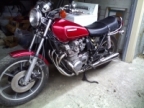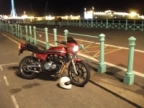Timing Troubles
- mackinnon0909
-
 Topic Author
Topic Author
- Offline
- User
-

Registered
- Posts: 17
- Thanks: 0
Timing Troubles
12 Jun 2015 09:18
I'm having a hard time getting the correct timing on my '78kz650sr. I got it close just by listening to it while I moved the points plate, but shes still lacking power at higher RPM's. Any tips?
Please Log in or Create an account to join the conversation.
- Tyrell Corp
-

- Offline
- User
-

Registered
- "You were made as well as we could make you"
- Posts: 1650
- Thanks: 261
Re: Timing Troubles
12 Jun 2015 09:36
Check your timing is advancing fully with a strobe; also the ATU cenfriugal advancer needs cleaning and lubing occasionally.
1980 Gpz550 D1, 1981 GPz550 D1. 1982 GPz750R1. 1983 z1000R R2. all four aces
Please Log in or Create an account to join the conversation.
- SWest
-

- Offline
- Sustaining Member
-

Registered
- 10 22 2014
- Posts: 23450
- Thanks: 2917
Re: Timing Troubles
12 Jun 2015 09:42
Do you have a manual?
Steve
Steve
Z1b1000 1975 Z1b
kzrider.com/forum/11-projects/598262-kz-...-will-it-live#672882
kzrider.com/forum/2-engine/597654-poser?start=240#704229
kzrider.com/forum/11-projects/598262-kz-...-will-it-live#672882
kzrider.com/forum/2-engine/597654-poser?start=240#704229
Please Log in or Create an account to join the conversation.
- floivanus
-

- Offline
- User
-

Registered
- Posts: 1055
- Thanks: 116
Re: Timing Troubles
12 Jun 2015 10:14
If running points, set the gap first (.014" max lift i believe) then set the static timing to the F mark, after doing both sides you should be good. Can set timing with a simple test light and be done. Recheck running with a timing light ($20 at advance/autozone etc) really nothing to it.
Setting timing by ear is a horriblly innacurate way to go. My father in law used to do it, and get things 'right' but honestly you end up usually too far advanced/retarded and lose a lot of performance.
Setting timing by ear is a horriblly innacurate way to go. My father in law used to do it, and get things 'right' but honestly you end up usually too far advanced/retarded and lose a lot of performance.
my bikes; 80kz1000(project), 77 gl1000, 74 h2 (project)
Past; 78 kz1000, 83 kz550
Andrew
Past; 78 kz1000, 83 kz550
Andrew
The following user(s) said Thank You: mackinnon0909
Please Log in or Create an account to join the conversation.
- SWest
-

- Offline
- Sustaining Member
-

Registered
- 10 22 2014
- Posts: 23450
- Thanks: 2917
Re: Timing Troubles
12 Jun 2015 10:20
A good ear is just that. My 69 F250 pings when set to spec. I have to retard it by ear. Gas isn't the same as it was then. I would never do it on these bikes. Manual??
Steve
Steve
Z1b1000 1975 Z1b
kzrider.com/forum/11-projects/598262-kz-...-will-it-live#672882
kzrider.com/forum/2-engine/597654-poser?start=240#704229
kzrider.com/forum/11-projects/598262-kz-...-will-it-live#672882
kzrider.com/forum/2-engine/597654-poser?start=240#704229
Please Log in or Create an account to join the conversation.
- 650ed
-

- Offline
- User
-

Registered
- Posts: 15339
- Thanks: 2833
Re: Timing Troubles
12 Jun 2015 10:53 - 12 Jun 2015 10:55mackinnon0909 wrote: I'm having a hard time getting the correct timing on my '78kz650sr. I got it close just by listening to it while I moved the points plate, but shes still lacking power at higher RPM's. Any tips?
Yes. Forget trying to tune it by ear. Simply turning the points plate is not how one sets the ignition. Get a new set of points and condenser and the proper tools (timing light, dwell meter, and 0.35 mm feeler gauge) and time it correctly. Everything you need can be had for very little money. In the mean time if you very carefully follow the instructions below your timing should be very close to accurate.
The manual has several pages of instructions, pictures, etc. on how to set the timing using the static method plus timing light, plus dwell meter. I can give you a fairly easy way that will get you in a pretty close ballpark without a timing light or dwell meter, but you will need a 0.35 mm feeler gauge and a multi-meter or other device to test continuity. To be very precise, the timing light and dwell meter will be needed.
Before attempting to replace or adjust the points the following is important to understand; timing is comprised of two separate components, and BOTH of these components MUST be set properly if the engine is to run well:
--- The GAP – this is the distance the points spread apart when fully open. This is set by adjusting the points. The GAP is the element that determines the DWELL. In essence, the DWELL is the number of degrees of points cam rotation that the points are closed and this controls the amount of time the coils receive a charge before firing the spark plugs.
--- The TIMING of the initial opening of the points (the point at which the continuity across the points breaks) controls the precise instant that the coils receive the signal to fire the spark plugs. This is set by turning the backplate AFTER the gap is set.
Remove the points cover on the right side of engine. Under it you will see 2 sets of points. The set on the left fires cylinders 1 & 4; the set on the right fires 2 & 3. When replacing points observe carefully how the little bits and pieces are arranged where the wires attach. Some of those pieces are actually insulators and if you leave any of them out or put them back in the wrong place the points will be grounded and won't work. Take a very close look at the contact surfaces of the points. If they are pitted you really should replace them. You can sand down pitted points, but they will quickly pit again. Replace one set of points at a time so you can look at the other set in case you get the little bits confused.
When adjusting the points, use a 17 mm wrench to turn the nut NEAR the end of the crankshaft clockwise while looking in the hole above that nut. (Do NOT use a wrench on the smaller bolt on the very end of the crankshaft to turn the engine.) Inside that hole you will see a vertical pointer cast into the casing. As you turn the 17 mm nut you will see a 1 & 4 and F and T roll by and then you'll see a 2 & 3 and F and T roll by. Each F and T has a line next to it.
Here's the method I use for static timing. I turn OFF the ignition. I disconnect the green wire near one coil and the black wire near the other coil. (This is not in the book, but it makes checking continuity much easier for me.) After installing the new points or cleaning up the old ones, turn the 17 mm nut while watching the points. When points set 1&4 are at their widest gap adjust them (by loosening the 2 screws that hold the points to the backplate) so the gap equals 0.35 mm. Turn the 17 mm nut clockwise through a full revolution again and double check this gap. Then repeat this for points set 3&4. Now set your meter to test continuity and clip one wire to the leaf spring on points set 1&4 and clip the other wire to ground. Turn the 17 mm nut clockwise until the 1&4 "F" mark aligns with the pointer mentioned above. You want the continuity across point set 1&4 to just break when the F mark aligns with the pointer. The idea is that when the continuity just fails is when the points will fire their respective coil and cylinders. In order to adjust the point at which continuity fails you loosen the 3 screws that hold the backplate to the engine and slightly turn the backplate until the meter shows a break in continuity. Once you have the 1&4 set timed properly you can check the 2&3 set to make sure they break when the 2&3 F mark aligns with the pointer (they should or something is not right). Don't forget to plug in the green and black coil wires when you are done, and put a little grease on the rubbing block felt. Assuming you are using new points of the correct type this should enable you to get the timing very close. Trying this with old points may give poor results, especially if the points are pitted and/or the rubbing blocks are worn.
After you have set the gap (which in effect sets the dwell) and the timing using the method above you can use a dwell meter and timing light to fine tune dwell and timing. If you have followed the above procedure carefully, very little if any fine tuning will be needed. Sorry this is so long. It's not as difficult as it sounds. Ed
1977 KZ650-C1 Original Owner - Stock (with additional invisible FIAMM horn)
Last edit: 12 Jun 2015 10:55 by 650ed.
The following user(s) said Thank You: mackinnon0909
Please Log in or Create an account to join the conversation.
- SWest
-

- Offline
- Sustaining Member
-

Registered
- 10 22 2014
- Posts: 23450
- Thanks: 2917
Re: Timing Troubles
12 Jun 2015 11:28
It can be done on the side of the road be eye just to get you home. If the points are sparking, you need new condensers and points.
Steve
Steve
Z1b1000 1975 Z1b
kzrider.com/forum/11-projects/598262-kz-...-will-it-live#672882
kzrider.com/forum/2-engine/597654-poser?start=240#704229
kzrider.com/forum/11-projects/598262-kz-...-will-it-live#672882
kzrider.com/forum/2-engine/597654-poser?start=240#704229
Please Log in or Create an account to join the conversation.
Moderators: Street Fighter LTD
